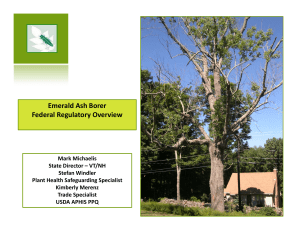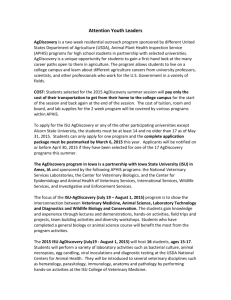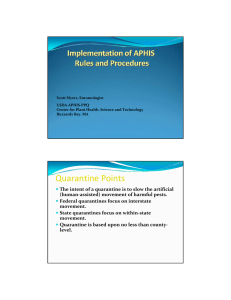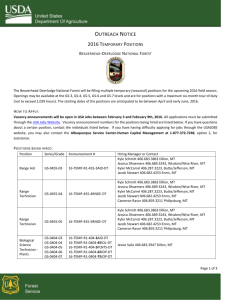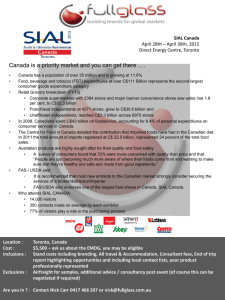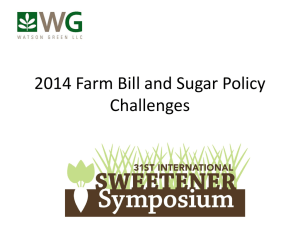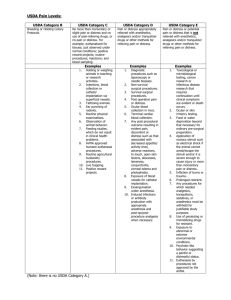Verifying Treatment Methods for Export of Forest Products
advertisement
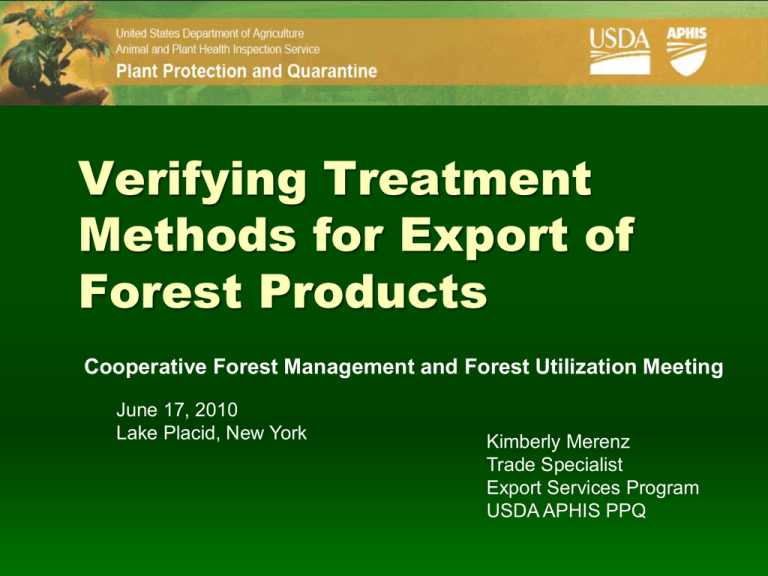
Verifying Treatment Methods for Export of Forest Products Cooperative Forest Management and Forest Utilization Meeting June 17, 2010 Lake Placid, New York Kimberly Merenz Trade Specialist Export Services Program USDA APHIS PPQ Phytosanitary Certification Internationally recognized plant health certification Not required by the USDA Indicates import requirements of foreign countries have been met Plants and un-processed plant products Commodity MUST be inspected before the shipment leaves the U.S. Exporter Responsibilities Apply in writing for inspection, sampling, and/or testing Contact an Authorized Certifying Official (ACO) Provide all necessary documentation Ensure commodity is available, provide labor and facilities Exporter Responsibilities, cont. Provide for required treatments or other actions Safeguard the certified shipment from infestation Comply with U.S. export control regulations Export only those plants or plant products that have been certified Import Permits Special permission granted by a foreign government’s department of agriculture to the importer Permits specify the requirements that will need to be met Permission may not be granted for prohibited plants or plant products – e.g. Elm plants from the U.S. to China Eligible Forest Products Trees Logs Lumber Wood Chips Some Processed Wood Products Regulations Are Specific To Each Country China’s regulations for maple logs are different than Taiwan’s Some countries allow green lumber to be imported, most require kiln drying to below 20% moisture or heat treatment. Kiln Drying (KD) Definition - A process in which wood is dried in a closed chamber using heat and/or humidity control to achieve a required moisture content [ISPM No 15, 2002]. Goal – to reduce the amount of moisture to a percentage that is not likely to support pests, regardless of temperature. KD Verification Evidence of kiln drying by “KD” marks on lumber Checking moisture content Inspecting kiln charge chart The ACO signing the phytosanitary certificate verifies the treatment. Heat Treatment (HT) Definition - The process in which a commodity is heated until it reaches a minimum temperature for a minimum period of time according to an official technical specification [ISPM N° 15, 2002; revised ICPM, 2005]. Goal – Reach a core temperature sufficient to ensure no pest can survive, regardless of moisture content. HT Verification For Coniferous Sawn Wood – Mills must be certified by Lumber Grading Agencies Participating in Mill Certification Programs for Coniferous Sawn Wood. The Agency provides a heat treatment certificate to the ACO. The Agency must have an MOU with the USDA for either EU countries, non-EU countries, or both. HT Verification, cont. There is no USDA HT Certification Program for Hardwood forest products, other than for solid wood packing material Logs Bark, Chips, Chunks, Shavings, Dust, Flour……. HT Verification, cont. If a country requires HT of a product, other than coniferous sawn wood – Exporter submits request to the USDA for initial evaluation. Kilns must be certified by either USDA, or a certifying agency, to the USDA standards. Exporter must sign a compliance agreement with the USDA. The ACO must verify the treatment. Wood Packing Material (WPM) The “Heat Treatment Program” was developed in order for the American Lumber Standard Committee (ALSC) to implement a quality control program for the official labeling of heat treated wood packaging material with the ISPM 15 official mark to signify compliance with the ISPM 15 standard. WPM, cont. The stamp on the WPM must be compliant with ISPM 15. Verification of HT is conducted by an ALSC approved agency. No phytosanitary certificate will be issued. MORE INFO: www.aphis.usda.gov/import_export/index Patrick Marino, Export Certification Specialist Patrick.F.Marino@aphis.usda.gov Kimberly Merenz, Trade Specialist Kimberly.D.Merenz@aphis.usda.gov Phone: 518-218-7510, Fax: 518-218-7518 QUESTIONS ??
